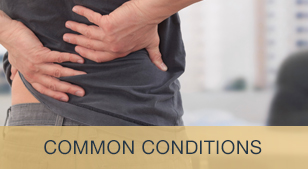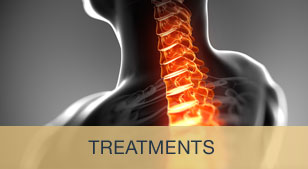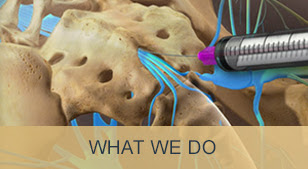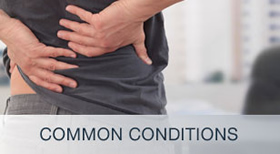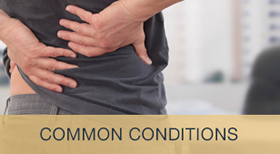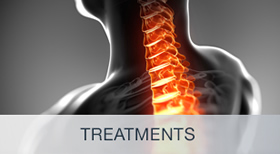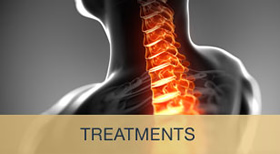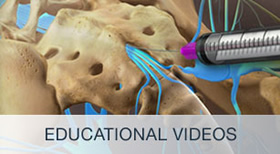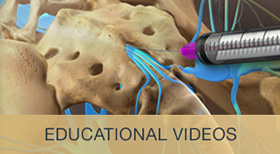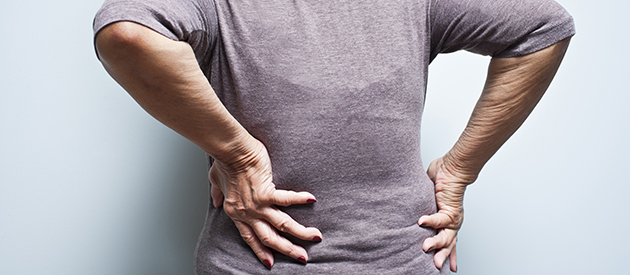Herniated Disc
Between each of the vertebrae of the spine are soft discs filled with a gelatinous substance. These rubbery discs provide a cushion for the vertebrae and help hold them in place. As we age, our discs lose some of their flexibility and become flatter. They may be additionally weakened by stress caused by too much body weight, incorrect lifting, sudden pressure, vigorous repetitive movements and smoking. This may result in tears in the outer annulus or wall holding the disc in place.
When one of these discs moves out of place or ruptures, it is considered a disc bulge or a herniated disc. Sometimes the herniated disc may press on nerves in the spinal canal, which results in arm, leg(sciatica),neck, or back pain. This irritation causes an inflammatory response by the body. The body overreacts and releases large amounts of inflammatory chemicals and cells. These cells and chemicals cause the nerve cells and the spinal cord to not only manufacture more of this "inflammatory soup", but makes the nerve endings extremely sensitive to any stimulation. This results in extreme pain with minimal movement. Depending on which nerve root is irritated, will dictate where your pain is. Sciatic nerve (L4,L5,S1) root irritation tends to cause pain in the back of the leg, while higher nerve roots L1 to L4 tend to cause pain in the hip, front of the leg, and/or groin. Remember the pain problem is not in the extremity, but in the irritation of the nerve root from the disc. You can have irritation of one nerve or multiple nerves with multiple symptoms including pain, weakness, numbness, or tingling. The pain can be intermittent or constant unilateral or bilateral.
Symptoms
When the herniated disk is in the lower portion of your spine, the symptoms may include back pain that extends into the buttocks and legs. When the herniated disk is in the upper portion of your spine, the resulting symptoms may include neck pain that extends into the shoulders and arms. You also might experience tingling, numbness, muscle spasms or weakness.
Diagnosis
In order to make a correct diagnosis of your back pain, your doctor will require a complete medical history. A physical exam will most likely include a check for loss of sensation or numbness, muscle strength and overall posture.
In many cases, your doctor will order X-rays to further examine the spine. Tests such as an MRI or CT scan, can provide detailed information about the size and location of the disk herniation.
Treatment
Treatments for herniated disks usually begin with bed rest, anti-inflammatories and pain medications as needed. Sometimes physical therapy can improve the symptoms. You may need epidural injections of a steroid to reduce the nerve irritation and facilitate healing. Dr. Campbell does 2 types of epidurals steroid injections, including transforaminal or interlaminar techniques. The type of epidural is determined by symptoms, location of pain, and past results. Dr. Campbell generally does 2-4 injections weekly until your Inflammation and pain are zero.
Spinal Stenosis
Spinal stenosis is the narrowing in one or more areas of the spinal canal as a result of injury or deterioration of the discs, joints or bones of the spine. Most cases of spinal stenosis develop as a result of the degenerative changes that occur during aging. Osteoarthritis is the main cause of spinal stenosis, since this condition causes deterioration of cartilage in the area that leads to the bones rubbing against each other. As bones make repeated abnormal contact, bone spurs form, narrowing the spinal canal.
Other causes of spinal stenosis are traumatic injury, herniated disc, ligament thickening and, in rare cases, spinal tumors, any of which can damage the alignment of the vertebrae. A subtype of spinal stenosis is foraminal stenosis. This condition is caused by a narrowing of the foramen, the opening that allows nerve roots to pass through.
Symptoms
Patients with spinal stenosis may experience a number of troubling symptoms. These may include:
- Pain in the back, neck, shoulders or extremities
- Muscle cramping
- Loss of sensation in affected areas
- Loss of balance
- Bladder or bowel dysfunction
Diagnosis
In order to diagnose spinal stenosis, a medical history and a physical examination are always necessary. The condition is often difficult to diagnose, not only because its symptoms may resemble the symptoms of other conditions, but because they may only occur intermittently. A diagnosis of spinal stenosis is usually achieved only after ruling out other disease conditions. Typically, imaging exams such as a spinal X-rays, MRI, CT or bone scans are administered to definitively diagnose the condition and to pinpoint the spinal region affected. An electromyography (EMG) may also be administered to measure electrical impulses in the affected skeletal muscles.
Treatment
Most cases of spinal stenosis can be effectively treated through conservative methods such as physical therapy, nonsteroidal anti-inflammatory drugs (NSAIDs), rest and a supportive back braces. In some situations, corticosteroid injections may be needed provide relief. Depending on your symptoms Dr. Campbell may elect to do epidural steroid injections or facet joint injections.
For more severe cases, surgical procedures such as a decompressive laminectomy, laminotomy or spinal fusion may be required to relieve pressure on the nerves. When the patient is diagnosed with foraminal stenosis, a surgical procedure known as a foraminotomy may be performed. This operation widens the area where the spinal nerve roots project from the spine.
For more information about Common Conditions, or to schedule an appointment, please call 484.468.1480.



